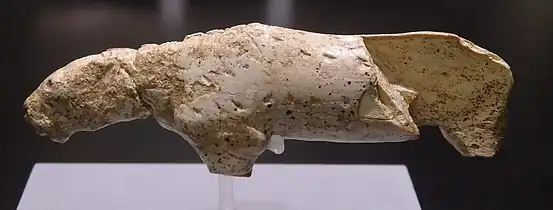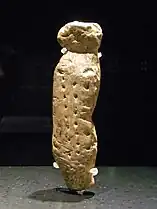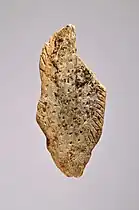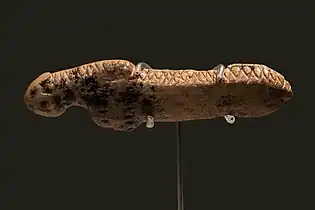Vogelherd (arula)
|
Vogelherd arula, tigisa koe Schwäbische Alb jakama getalte Germana, tir ayaf is abdiizvugalaf debak ke Lekeraporugal. Tamavafa GadakiewegaBelca dem tevoya abdiizvugalafa arula ( don Vogelherd arula ) milvemon tigisa getalte Germana va tano katcalapafo izvaxo ke tawava tadler nume bak 2007 wetce arayaf debak ke tamavafa gadakiewega ke UNESCO zo bendeyer. Rawopaf debakKoe Lone krant, Vogelherd arula tir tela lotaltefa tigisa. Tir dem baroyo kolanixo gluyakirafo gu lupaxa koe pistxo. Bata betsava varon zo vestayar ise zo kaljoxayar. Taneafa kosmara isu divsidara bak 1930-e sanda gan Gustav Riek is Hermann Mohn zo skuyud. Soe banugale divmimayan baspieks sure gire zo joxayad ise loeke zo drunayad. Evlara va serixo ke Vogelherd arula va evlaks wali milgaf Lekeraporugal is Gelkeraporugal nekir. Kotak ke koafizayani seri vas jontik sulemaf kudjot ruldar, i vas lo epuyun kum melmakolafa wula. Bat kudjot va yona katca bliyisa bak oprugal volad, i va tulon arulaf krapol is melmakol is govitaf okol is dere nudol. Ayakoraf kudjot is toloy stogoyeyen val is yona ingasa muka va olkotceem tukotrad. Evlara kan 14-e beba al exoner da belikafa klaa ke bada ke Aurignac sare ke Vogelherd arula tir 35000 ik 41600 AR tanda. Dum yona dzeta ke Hohle Fels arula, telyona ke Vogelherd arula va yona welmafa tcala ke rupolafa kotcara divnedid, i va tcala tisa pragucayan nekiks ke pist gan pragara ke arulaf rupol. Sulemafi seri
Ayafa muka isu yambaxa
Dere rupec |
Teza:GermanaUNESCOTamavafaGadakiewega | |||||||||||||||||||||||||||||||||||||||||||||||||||||||||||||||||||||||||||||||||||||||||||||||||||||||||||||||||||||||||||||||||||||||||
Vuestexa
- (en) Fiona Coward is Robert Hosfield is Matt Pope is Francis Wenban-Smith, The Early Upper Paleolitic and the art of Central Europe, Settlement, Society and Cognition, ed. Human Evolution , Cambridge University Press, 2015, 448 p.
- (en) Michael Bolus, The Swabian Jura, History of Research and the Aurignacian of the Sites in the Swabian Jura, Nuria Sanz, Human origin sites and the World Heritage Convention in Eurasia, ed. UNESCO, vol. n° 41, 2015, p. 166
- (en) Timothy Insoll, The Oxford Handbook of Prehistoric Figurines
- (en) Andreas Taller is Michael Bolus is Nicholas J. Conard, The Magdalenian of Hohle Fels Cave and the Resettlement of the Swabian Jura after the LGM, Modes de contacts et de déplacements au paléolithique eurasiatique, Actes du Colloque international de l'UISPP, Université de Liège, 28–31/05/2012, coll. « Erault et Archéologiques », 2014, ISBN 978-2-87985-305-5
- (en) Judy yun Chang, The Swabian Jura : Vogelherd - The lithic technology of the Swabian Aurignacian and its importance for early modern humans, Nuria Sanz, Human origin sites and the World Heritage Convention in Eurasia, vol. 41, UNESCO Publishing, 2015, 166 p.
- (en) Nicholas J. Conard is Laura B. Niven, The Chronostratigraphy of the Upper Paleolithic Deposits at Vogelherd, Mitteilungen der Gesellschaft für Urgeschichte, vol. 12, 2003
- (en) Nicholas J. Conard is Pieter M. Grootes is Fred H. Smith, Unexpectedly recent dates for human remains from Vogelherd, Nature, n° 430, 2004
- (de) Nicholas J. Conard, Alexander Janas et Mohsen Zeidi, Neues aus dem Lonetal : Ergebnisse von Ausgrabungen an der Fetzershaldenhöhle und dem Vogelherd, Archäologische Ausgrabungen in Baden-Württemberg, 2015
- (en) Ewa Dutkiewicz, The Vogelherd Cave and the discovery of the earliest art – history, critics and new questions, dans Nuria Sanz, Human origin sites and the World Heritage Convention in Eurasia, vol. 41, UNESCO, 2015, 166 p.
- (de) Joachim Hahn, Der Vogelherd und seine Einordnung », dans Kraft und Aggression : die Botschaft der Eiszeitkunst im Aurignacien Süddeutschlands ?, Institut für Urgeschichte der Universität Tübingen. Tübingen, Archaeologica Venatoria, 1986, 254 p.
- (de) Ulrich Lehmann, Vogelherd und Bocksteinschmiede im Lonetal, E&G – Quaternary Science Journal, vol. 4-5, n° 1, 1954
- (en) Laura Niven, From carcass to cave : Large mammal exploitation during the Aurignacian at Vogelherd, Germany, Journal of Human Evolution, Elsevier, n° 53, 2007
- (de) Gustav Riek, Paläolitliische Station mit Tierplastiken und menschlichen Skelettresten bei Stetten ob Lontal., Germania, Tübingen, vol. XVI, 1932
- (en) A. Ronen, The Burins of Vogelherd Aurignacian (Germany) and those of the French Aurignacian : a Comparison, Quärter, Tel-Aviv, 1970
- (de) Eberhard Wagner, Eine Löwenkopfplastik au Elfenblein von der Vogelherdhöhle, Fundber, vol. 6, n° 23, 1981
- (de) Jürgen Weiner is Harald Floss, Eine Schwefelkiesknolle aus dem Aurignacien vom Vogelherd, Baden-Württemberg. Zu den Anfängen der Feuererzeugung im europäischen Paläolithikum, Archäologische Informationen, vol. 27, n° 1, 2004 (ISSN 0341-2873, DOI 10.11588/ai.2004.1.12609)
- (de) Robert Wetzel, Quartärforschung im Lonetal, Quaternary, Tübingen, vol. 106, n° 4-5, 1954









.jpg.webp)

